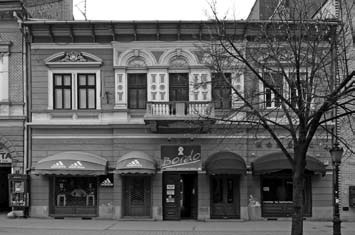Bela Farkas, the son of the clarinetist Akasha Bućkai and the young singer Neli Gaboš, was born on February 24, 1894 in Rijeka. Farcash’s surname was given to his mother’s mother in the name of Subotic engineer Jozef Farkaš. He never met his father even though he really wanted it. He spent his childhood and youthful days in Subotica and […]
Прочитај више
The city core of Subotica was proclaimed a spatial cultural and historical unit in 1986 (by the decision of MZZSK Subotica No. 101-4 dated 13.12.1986), and it was established for the city core of great importance in 1991 (Official Gazette SRJ 25/91 ). The historical core of Subotica is located on the territory of the Municipality of Subotica, comprising the […]
Прочитај више
The town house was designed in 1907, built 1908/10. but due to works on the interior furnishings it was finally finished in 1912 as an extraordinary example of the synthesis of architecture and art crafts, a monument of one time. This huge building dominates the center of Subotica. In spite of the Art Nouveau wall paintings, the silent rhythm of […]
Прочитај више
The building was completed in 1896 and has preserved its original form to date and is one of the most significant examples of eclectic architecture in the city. It was created by the renewal and upgrading of the centenary Baroque curia of the Skenderović family of Subotica. The building faces the square with a frontal block, and the side wings […]
Прочитај више
The building of the old gymnasium in Subotica was built in 1817, but the City Senate in 1895 decided to build a new building, according to Ferenc Rajhla’s projects, and the construction contractor was Karolj Molcer. Construction began in 1896, and the building was finally handed over to use in 1900. This imposing object was created by Rajhl in the […]
Прочитај више
The building was erected for Dr. Mihalja Gereb at the end of the XIX century, according to the projects of the Budapest architect Deže Jakab. The project was made in 1894 and includes the early works of this exceptional architect who designed the building with a special emphasis on the decorative component made in the spirit of the Neo-Baroque. The […]
Прочитај више
Subotica is most likely to be created in the 13th century during the Hungarian king Bela IV, on a trade road that links the wealthy regions of Erdzel with the craft centers on the slopes of the eastern Alps. The settlement is formed at a point where this time, on a one-day walk from the Segedin harbor, crosses the junction […]
Прочитај више
Very similarly the house of Simon Dominus was designed, which was designed by Titus Mackov in 1891. Like Halbrover’s building and this is a single-storey house with the dominance of Renaissance elements, especially on the ground floor where the wall canvas is made in massive rust. Four arched portals were roastically processed. The symmetry of the façade has been consistently […]
Прочитај више
The archaeological site is located on a sandy hill near Ludaš Lake, northeast of Subotica. During the research works in 1951, a site was found in a layer of wood in which the traces of the fire were observed. An artifact whose cultural affiliation was not determined was found. The sandstone around the lake was caused by eolic erosion, so […]
Прочитај више
The corner one-storey building built for Jovan Dimitrijevic in 1881 according to the projects of the Subotica architect Tito Mackovic, who, with his eclectic works with prevailing non-Renaissance characteristics, gave the main stamp a whole street move. The object is symmetrically conceived with two lateral rhizalites, and in the intermediary part, a pedestrian entrance is marked centrally with two pillars, […]
Прочитај више










